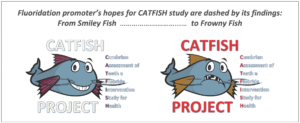The final published report of a large 10-year fluoridation study in the northwest of England, called the CATFISH study, has concluded that fluoridation’s effects on tooth decay in children are “very modest” and “much smaller than previous studies have reported” [Goodwin 2022]. In England, this long-awaited study was funded by the fluoridation-promoting national health authorities who apparently hoped it would underpin efforts by the government to extend fluoridation to all of England. Fluoridation currently is only imposed on 10% of the population, a proportion that has not increased in 30 years. Instead of supporting more fluoridation, the results of the CATFISH study are a strong blow against it.
The report concludes:
“The 4% difference we found may not be large enough to convince communities to support water fluoridation schemes. Other ways of preventing tooth decay may be better now that use of fluoride toothpaste is so common and levels of tooth decay are much lower than they were 40 years ago.

The study compared children from two parts of Cumbria, one with artificial fluoridation (averaging about 0.9 mg/L), and the other without. Five year olds with fluoridation since birth had only about 0.3 fewer cavities or fillings in their baby teeth than the non-fluoridated children. Only 4% fewerwere caries-free. For permanent teeth in 11 year olds, the difference in cavities or fillings was even lower, with only about 0.2 fewer in those with fluoridation from age 5 to 11, compared to non-fluoridated children who never had fluoridation. The meager benefit in permanent teeth resulted in only 3% fewer caries-free children among the 11 year olds. The study also failed to show any significant extra reduction in caries for deprived children, so fluoridation did not reduce disparities.
The study has been touted as the most up-to-date evaluation of the effectiveness of water fluoridation. It was intended to fill the gaping evidence gap that was revealed by the two strongest systematic reviews to date, the York Review of 2000 and the Cochrane Review of 2015. Both those reviews concluded that despite claims of fluoridation promoters, existing studies were of relatively low quality and were at high risk of bias. Furthermore, the studies were almost all prior to the mid 1970s, before fluoride toothpaste use became common. Dental researchers concur that fluoride toothpaste likely played the largest role in the steady decline of tooth decay in all developed countries over the last 50 years, because most countries have not been fluoridated.
Besides finding only very modest benefits on average, the CATFISH study results also undermine the claim of fluoridation proponents that fluoridation helps poor children the most. The study found no significantly better results in the most deprived compared to the least deprived children. Fluoridation proponents sometimes make the paternalistic argument that poorer children do not use fluoridated toothpaste as much as wealthier children and therefore need fluoridation which doesn’t require any effort from the children. The CATFISH study undermines this argument two ways: by finding no greater benefit in the poorest children and by finding they brushed their teeth as much as wealthier children.
An economic evaluation was also done for the study, and despite overly optimistic assumptions, found a return on investment (ROI) that was a tiny fraction of what has long been claimed for fluoridation. The ROI was 1/5th what Public Health England claimed for fluoridation in 2016 when PHE launched its current push to expand fluoridation to all of England. The ROI is also below that for the ChildSmile program in Scotland, which is a program of supervised toothbrushing in preschools, initiated because Scotland had effectively banned fluoridation in 1983.
The probability that fluoridation in Cumbria produced a net economic benefit at all is also in doubt, with the paper estimating there was only a 68% probability that it produced a net benefit for those 0-12 years old, which means there was conversely a 32% probability that the program suffered a net economic loss.
Even with the dismal caries and economic benefits, which bring serious doubt as to whether there are any grounds to try to expand fluoridation, the conclusion is even dimmer when the serious biases of the study are taken into account. The economic evaluation assumed there were no costs from dental fluorosis or lost IQ, both very costly adverse effects of fluoridation with strong supporting scientific evidence. Even before the economic evaluation, the study appears to be seriously confounded because the fluoridated group had a much higher proportion of high income families (40%) than the non-fluoridated (17%), yet income was never adjusted for in any analyses. The small dental and economic benefits found in the study may have actually been due to the disproportionate number of wealthy families in the fluoridated area who enrolled their children compared to in the non-fluoridated area, since it is well documented that wealthier groups have lower tooth decay rates.
Instead of adjusting for income, which was measured at the individual level, the study adjusted for deprivation, which was a group-level or ecological measure. The group-level deprivation scores did not differ greatly between the fluoridated and non-fluoridated groups, so adjusting for deprivation would not remove the confounding by income. It appears the CATFISH study fell prey to the ecological fallacy, leading to an overestimate of benefits.
The CATFISH study found, at best, marginal dental and economic benefits. Instead of laying the foundation for the push to expand fluoridation in England, it should be the final wrecking ball for the house-of-cards of weak arguments that dental interests have promoted to try to sell fluoridation.
